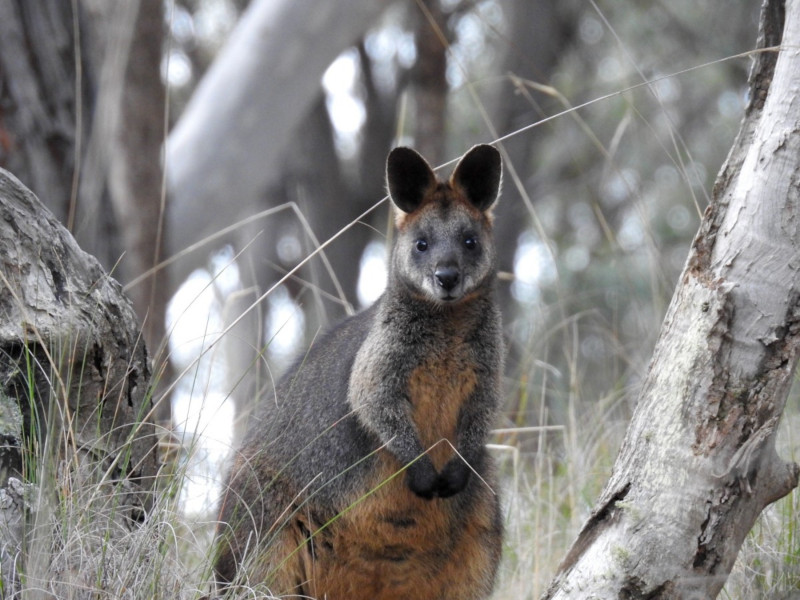
Swamp Wallaby Facts
- This amazing marsupial, similar to a kangaroo, most frequently goes by the common name of the Swamp Wallaby. That’s not its only name, though, by far. In fact, this fascinating creature also goes by a relatively long list of alternate common names.
- These include the fern wallaby, black-tailed wallaby, black wallaby, stinker, black stinker, and black pademelon. The terms of stinker and black stinker, though, derive from its distinctive odor. Many who encounter it compare it to the smell of a swamp.
- Regardless of the common name one uses, professional researchers know it better by its scientific name. That’s the comparatively simple to pronounce term of Wallabia bicolor. This animal, in fact, represents the only known living member of its Genus.
- The French zoologist, Anselme Gaetan Desmarest recorded the first known official recognition of the species in 1804. Another French zoologist, Edouard Louis Trouessart, later made the formal recognition of its status as the sole member of its group.
- Quite sadly, the awesome Swamp Wallaby appears to have been eradicated in parts of its native range. In its remaining range, however, it seems to be maintaining a stable population base. The IUCN therefore currently list it as Least Concern on its Red List.
- The mammal nevertheless faces threats to its continue survival. One of these continues to be that of habitat loss, due to human expansion. It greatest threat, however, no doubt comes from the ever-increasing danger now posed by ongoing climate change.
Related Articles
Swamp Wallaby Physical Description
The marvelous Swamp Wallaby, it must be noted, impresses those who encounter it for reasons other than sheer physical size. That’s because, especially compared to the four currently known forms of its nearest relative, the kangaroo, it’s a fairly small species.
Like many mammals, however, it also displays a slight degree of the physiological trait of sexual dimorphism. In its case, though, this characteristic manifest itself in terms of pure physical size. Specifically, males average slightly larger than the females.
To be precise, males of the remarkable Swamp Wallaby attain an average body length of roughly 30 in (76 cm). The females, meanwhile, reach a somewhat shorter average body length of about 28 in (70 cm). This measurement does not include the tail, though.
In both genders, this appendage attains a length approximately equal to that of the body itself. Males also achieve a moderately greater weight than the females. The larger males average a weight of about 37 lb (17 kg). Females, however, only average around 29 lb (13 kg).
The name of the species, bicolor, stems from its coloring. The basic color of the coat is a dark to light gray. A dark brown to black region appears on the back of the Swamp Wallaby, though. A light yellow to dark orange section also develops on the chest of the animal.
- Kingdom: Animalia
- Phylum: Chordata
- Class: Mammalia
- Order: Diprotodontia
- Family: Macropodidae
- Genus: Wallabia
- Species: W. bicolor
Swamp Wallaby Distribution, Habitat, and Ecology
Unfortunately for it, the truly amazing Swamp Wallaby evolved as native to a very small section of the world. That region’s also highly specific, as well. That’s due to the regrettable fact that this intriguing specimen of evolution only appears natively in eastern Australia.
Even more precisely, it currently only lives in a section of the continent that extends from southwestern Victoria to northern sections of Queensland. This zone of habitation also mainly hugs areas along the coast, reaching only a relatively short distance inland.
Previously, it appeared in most of the southeastern portions of the continent, however. Wherever it appears, though, it displays highly specific preferences in its choice of habitat. The marsupial primarily lives in regions of woodlands and forest, with thick undergrowth.
The beautiful Swamp Wallaby evolved as a primarily nocturnal creature. Typically emerging at night to feed, therefore, when it does it consumes a wide range of local plant life. These mainly include grasses, scrubs, but sometimes include local agricultural species.
This animal evolved another fascinating trait, exhibited by fewer than 100 known mammals. That’s the trait known as embryonic diapause. This literally allows it to become pregnant while already pregnant. Due to this, many females spend their entire adult life pregnant.
Nature further created in this species a principally solitary creature. One of the few exceptions to this characteristic occurs during feeding, however. At this time, it frequently congregates into small groups. In turn, though, it appears to have very few natural predators.
Species Sharing Its Range
Check out our other articles on Rio Tinto, Bornean Flat Headed Frog, 5 Remarkable Canadian Mammals, Emerald Swallowtail, Epaulette Shark, Satanic Leaf-Tailed Gecko, Great Dismal Swamp
